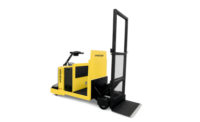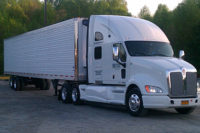How to handle odd shapes in the warehouse

Not every product offered by a manufacturer or distributor can be put in a regular, standard box or pallet for storage in a warehouse. Heavy, bulky items and irregular shapes need to be stored in ways that save on space and can be handled efficiently and safely. Items like rounds of ice cream or triangular boxes don’t fit nicely on storage racks because of their odd shape, size and weight. Putting these items individually on storage shelves can be difficult if shelves are made of wire where the items may tilt and not sit straight, making them unsafe for storage and handling. Distribution centers should be designed to store heavier items within the golden zone, the area closest to the picker’s waist, which doesn’t require them to bend or reach.
Dense, heavy products often must be handled manually because of their size and weight. In the warehouse, workers will manually pick these heavy items from pallets on the floor or on racks. To reach items in the back of the shelves, workers have to reach deep into the racks and pull items forward. This can harm the picker’s back, pulling the awkwardly shaped and heavy item. If workers are commonly fatigued or injured, productivity can suffer.
Odd-shaped, heavy items need to be stored on shelves made with full width rollers that provide excellent support. Rollers must be made of durable steel, so that they will not snap or buckle under the extra pressure. Shelves should be angled, so products flow forward. Using shelves with fractional pitch stops items from careening down the roller tracks and toppling over. End caps or brackets ensure that products stop at the bottom of the shelf and don’t fall off.
Flowing round, bulky objects have been a long-standing challenge in the world of carton flow. This challenge is one that many food and beverage distributors face on a daily basis.
If the items you are storing are using the first-in, first-out (FIFO) system, guard rails can be helpful. FIFO is important for companies that distribute products with expiration dates, such as food and beverage. It is a safe practice that ensures products will not expire or go bad. With FIFO, the oldest products are used or picked first, ensuring product quality and safety. When products are picked for an order, newer arrived products slide forward from the back to replace the just-picked item. Replenishment occurs from the back of the shelves.
When storing odd-shaped or round objects on a pitched surface, the objects tend to run forward at the same time, and because they are round, they don’t always stay right in a perfect line. Often, gravity will force them to run to the left or right of the object in front of it, as there are no surfaces to lie flat against. Think of a guard rail like the bumpers in bumper bowling. They keep you from going off the lane. That’s the goal.
The premium cost of freezer and cooler construction, coupled with the cost of maintaining appropriate temperatures, forces companies to increase pick facings without building more freezer or cooler facilities in their distribution center. Facilitating every product that customers need at -30°F can make or break a distribution center. One grocery distributor with a SKU count of 12,000 had an issue with space, so they decided to go vertical. Instead of picking off pallets, the company put case flow racks from floor to ceiling. Now the company is able to get more pick faces into the freezer and refrigerators. The company also found that the flow racks they selected used aluminum rollers with plastic bushings designed for low-temperature applications.
There are many choices of storage medium for the refrigerated warehouse and distribution center for handling heavy, odd-shaped products. Working with a company that specializes in order picking solutions ensures challenges and issues will be addressed, empowering businesses to improve productivity and ergonomics and save on warehouse space.
Looking for a reprint of this article?
From high-res PDFs to custom plaques, order your copy today!





